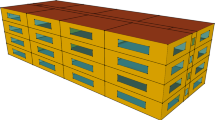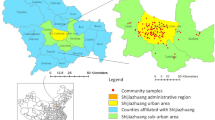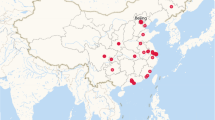Abstract
A critical aspect of air pollution exposure assessments is estimation of the air exchange rate (AER) for various buildings where people spend their time. The AER, which is the rate of exchange of indoor air with outdoor air, is an important determinant for entry of outdoor air pollutants and for removal of indoor-emitted air pollutants. This paper presents an overview and critical analysis of the scientific literature on empirical and physically based AER models for residential and commercial buildings; the models highlighted here are feasible for exposure assessments as extensive inputs are not required. Models are included for the three types of airflows that can occur across building envelopes: leakage, natural ventilation, and mechanical ventilation. Guidance is provided to select the preferable AER model based on available data, desired temporal resolution, types of airflows, and types of buildings included in the exposure assessment. For exposure assessments with some limited building leakage or AER measurements, strategies are described to reduce AER model uncertainty. This review will facilitate the selection of AER models in support of air pollution exposure assessments.
This is a preview of subscription content, access via your institution
Access options
Subscribe to this journal
Receive 6 print issues and online access
$259.00 per year
only $43.17 per issue
Buy this article
- Purchase on Springer Link
- Instant access to full article PDF
Prices may be subject to local taxes which are calculated during checkout



Similar content being viewed by others
References
Klepeis NE, Nelson WC, Ott WR, Robinson JP, Tsang AM, Switzer P et al. The national human activity pattern survey (NHAPS): a resource for assessing exposure to environmental pollutants. J Expo Anal Environ Epidemiol 2001; 11: 231–252.
American Society of Heating, Refrigerating, and Air Conditioning Engineers. The 2009 ASHRAE Handbook-Fundamentals. American Society of Heating, Refrigerating, and Air Conditioning Engineers: Atlanta, GA. 2009.
Bell ML, McDermott A, Zeger SL, Samet JM, Dominici F . Ozone and short-term mortality in 95 US urban communities, 1987-2000. JAMA 2004; 292: 2372–2378.
Breen MS, Breen M, Williams RW, Schultz BD . Predicting residential air exchange rates from questionnaires and meteorology: model evaluation in central North Carolina. Environ Sci Technol 2010; 44: 9349–9356.
United States Environmental Protection Agency Exposure Model for Individuals (EMI). Available at http://www.epa.gov/heasd/emi.
Burke JM, Zufall MJ, Ozkaynak H . A population exposure model for particulate matter: case study results for PM2.5 in Philadelphia, PA. J Expo Anal Environ Epidemiol 2001; 11: 470–489.
United States Environmental Protection Agency. Total Risk Integrated Methodology (TRIM) - Air Pollutants Exposure Model Documentation (TRIM.Expo/APEX, Version 4.4) Volume I: User’s Guide, EPA-452/B-12-001a. Office of Air Quality Planning and Standards, US EPA: Research Triangle Park, NC, Available at http://www.epa.gov/ttn/fera/human_apex.html.
United States Environmental Protection Agency. Total Risk Integrated Methodology (TRIM) - Air Pollutants Exposure Model Documentation (TRIM.Expo/APEX, Version 4.4) Volume II: Technical Support Document, EPA-452/B-12-001b. Office of Air Quality Planning and Standards, US EPA: Research Triangle Park, NC, Available at http://www.epa.gov/ttn/fera/human_apex.html.
United States Environmental Protection Agency Emergency Management Databases and Tools. Available at http://www.epa.gov/osweroe1/tools.htm.
Wallace L, Williams R . Use of personal-indoor-outdoor sulfur concentrations to estimate the infiltration factor and outdoor exposure factor for individual homes and persons. Environ Sci Technol 2005; 39: 1707–1714.
Liu DL, Nazaroff WW . Modeling pollutant penetration across building envelopes. Atmos Environ 2001; 35: 4451–4462.
Chan WR, Nazaroff WW, Price PN, Gadgil AJ . Effectiveness of urban shelter-in-place-I: idealized conditions. Atmos Environ 2007; 41: 4962–4976.
Ekberg LE . Relationship between indoor and outdoor contaminants in mechanically ventilated buildings. Indoor Air 1996; 6: 41–47.
US EPA. Integrated Science Assessment of Ozone and Related Photochemical Oxidants - Third External Review Draft. US Environmental Protection Agency: Washington, DC. 2012.
US EPA. Integrated Science Assessment for Particulate Matter (Final Report). US Environmental Protection Agency: Washington, DC. 2009.
Meng QY, Spector D, Colome S, Turpin B . Determinants of indoor and personal exposure to PM2.5 of indoor and outdoor origin during the RIOPA study. Atmos Environ 2009; 43: 5750–5758.
Williams R, Suggs J, Rea A, Sheldon L, Rodes C, Thornburg J . The Research Triangle Park particulate matter panel study: modeling ambient source contribution to personal and residential PM mass concentrations. Atmos Environ 2003; 37: 5365–5378.
Wallace L, Williams R, Suggs J, Jones P . Estimating Contributions of Outdoor Fine Particles to Indoor Concentrations and Personal Exposures: Effects of Household Characteristics and Personal Activities. United States Environmental Protection Agency: Washington, DC. 2006.
Allen RW, Adar SD, Avol E, Cohen M, Curl CL, Larson T et al. Modeling the residential infiltration of outdoor PM2.5 in the multi-ethnic study of atherosclerosis and air pollution (MESA Air). Environ Health Perspect 2012; 120: 824–830.
US EPA. Integrated Science Assessment for Carbon Monoxide (Final Report). US Environmental Protection Agency: Washington, DC. 2010.
Chan WR, Nazaroff WW, Price PN, Gadgil AJ . Effectiveness of urban shelter-in-place-II: residential districts. Atmos Environ 2007; 41: 7082–7095.
Chan WR, Nazaroff WW, Price PN, Gadgil AJ . Effectiveness of urban shelter-in-place III: commercial districts. Build Simul 2008; 1: 144–157.
Persily AK . Evaluating building IAQ and ventilation with indoor carbon dioxide. ASHRAE Trans 1997; 103: 1–12.
ASTM 2003. Test Method for Determining Air Leakage Rate by Fan Pressurization. Standard E779-03. American Society for Testing and Materials: West Conshohocken, PA,. 2003.
Chan WR, Nazaroff WW, Price PN, Sohn MD, Gadgil AJ . Analyzing a database of residential air leakage in the United States. Atmos Environ 2005; 39: 3445–3455.
Orme M . Applicable Models for Air Infiltration and Ventilation Calculations, Technical Note 51. International Energy Agency Air Infiltration and Ventilation Centre: Sint-Stevens-Woluwe: Belgium. 1999.
Murray DM, Burmaster DE . Residential air exchange rates in the United States: empirical and estimated parametric distributions by season and climatic region. Risk Anal 1995; 15: 459–465.
Koontz MD, Rector HE . Estimation of distributions for residential air exchange rates (Final Report). United States Environmental Protection Agency: Washington, DC. 1995.
Williams R, Rea A, Vette A, Croghan C, Whitaker D, Stevens C et al. The design and field implementation of the Detroit Exposure and Aerosol Research Study. J Expo Sci Environ Epidemiol 2009; 19: 643–659.
Yamamoto N, Shendell DG, Winer AM, Zhang J . Residential air exchange rates in three major US metropolitan areas: results from the Relationship Among Indoor, Outdoor, and Personal Air Study 1999-2001. Indoor Air 2010; 20: 85–90.
Brown KW, Sarnat JA, Suh HH, Coull BA, Koutrakis P . Factors influencing relationships between personal and ambient concentrations for gaseous and particulate pollutants. Sci Total Environ 2009; 407: 3754–3765.
Lagus PL, Grot RA, Lagus Applied Technology, Inc Consultant Report: Air Change Rates in Non-Residential Buildings in California. California Energy Commission: Sacramento, CA. 1995.
Cummings JB, Withers CR, Moyer N, Fairey P, McKendry B . Final report: uncontrolled air flow in non-residential buildings. Florida Solar Energy Center: Cocoa, FL. 1996.
Bennett DH, Fisk W, Apte MG, Wu X, Trout A, Faulkner D et al. Ventilation, temperature, and HVAC characteristics in small and medium commercial buildings in California. Indoor Air 2012; 22: 309–320.
Persily AK, Grot RA . Pressurization testing of federal buildings. In: ASTM STP 904 Trechsel HR, Lagus PL, (eds). Measured Air Leakage of Buildings. American Society for Testing and Materials: Philadelphia. 1986 pp 184–200.
Persily AK, Gorfain J, Brunner G . Survey of ventilation rates in office buildings. Build Res Inf 2006; 34: 459–466.
Sherman M . Estimation of infiltration for leakage and climate indicators. Energy Build 1987; 10: 81–86.
McWilliams J, Jung M . Development of a Mathematical Air-Leakage Model from Measured Data, Report LBNL-59041. Lawrence Berkeley National Laboratory: Berkeley, CA. 2006.
Laschober RR, Healy JH . Statistical analyses of air leakage in split - level residences. ASHRAE Trans 1964; 70: 364–374.
Wang FS, Sepsy CF . Field studies of the air tightness of residential buildings. In: Hunt CM, King JC, Trechsel HR, (eds). Building Air Change Rate and Infiltration Measurements, STP 719. American Society for Testing and Materials: Philadelphia, PA. 1980 pp 24–35.
Goldschmidt VW, Leonard GR, Ball JE, Wilhelm DR . Wintertime infiltration rates in mobile homes. In: Hunt CM, King JC, Trechsel HR, (eds). Building Air Change Rate and Infiltration Measurements, STP 719. American Society for Testing and Materials: Philadelphia, PA. 1980 pp 107–124.
Malik N . Field studies of dependence of air infiltration on outside temperature and wind. Energy Build 1978; 1: 281–292.
Nazaroff WE, Feustel H, Nero AV, Rexvan KL, Grimsrud DT, Essling MA et al. Radon transport into a detached one-story house with a basement. Atmos Environ 1985; 19: 31–46.
Wallace LA, Emmerich SJ, Howard-Reed C . Continuous measurements of air change rates in an occupied house for 1 year: the effect of temperature, wind, fans, and windows. J Expo Anal Environ Epidemiol 2002; 12: 296–306.
Persily AK . Measurements of air infiltration and airtightness in passive solar homes. In: Trechsel HR, Lagus PL, (eds). Measured Air Leakage of Buildings, STP 904. American Society for Testing and Materials: Philadelphia, PA. 1986 pp 46–60.
Feustel HE . Mathematical modeling of infiltration and ventilation. Air Infiltration and Ventilation Centre (AIVC) Conference: Dipoli, Finland, Paper 8 1989 Available at http://www.aivc.org.
Dietz RN, Goodrich RW, Cote EA, Wieser RF . Detailed description and performance of a passive perfluorocarbon tracer system for building ventilation and air exchange measurement. In: Trechsel HR, Lagus PL, (eds). Measured Air Leakage of Buildings. American Society for Testing and Materials: Philadelphia. 1986 pp 203–264.
Sherman MH, Grimsrud DT . Infiltration-pressurization correlation: simplified physical model. ASHRAE Trans 1980; 86: 778–807.
Walker IS, Wilson DJ . Evaluating models for superposition of wind and stack effects in air infiltration. Build Environ 1993; 28: 201–210.
Sherman MH . Superposition in infiltration modeling. Indoor Air 1992; 2: 101–114.
Humphreys M, Nicol JF . Understanding the adaptive approach to thermal comfort. ASHRAE Techn Data Bull 1998; 14: 1–14.
De Dear R, Brager GS . The adaptive model of thermal comfort and energy conservation in the built environment. Int J Biometeorol 2001; 45: 100–108.
Palmiter L, Francisco PW . Modeled and Measured Infiltration Phase III: A Detailed Case Study of Three Homes. (Technical Report). Ecotope Inc: Seattle, WA. 1996.
Wang W, Beausoleil-Morrison I, Reardon J . Evaluation of the Alberta air infiltration model using measurements and inter-model comparisons. Build Environ 2009; 44: 309–318.
Walker IS, Wilson DJ . Field validation of algebraic equations for stack and wind driven air infiltration calculations. HVAC&R Res 1998; 4: 119–140.
Shaw CY, Tamura GT . The calculation of air infiltration rates caused by wind and stack action for tall buildings. ASHRAE Trans 1977; 83: 145–158.
Keefe D . Blower door testing. J Light Construct 2010, 1–7.
American Society of Heating, Refrigerating, and Air Conditioning Engineers. ASHRAE Standard 62.1-2010: Ventilation for Acceptable Indoor Air Quality. American Society of Heating, Refrigerating, and Air Conditioning Engineers: Atlanta, GA,. 2010.
United States Department of Energy. Housing Characteristics: Residential Energy Consumption Survey. Energy Information Administration: Washington, DC. 2001.
Price PP, Sherman M, Lee RH, Piazza T . Study of Ventilation Practices and Household Characteristics in New California homes, CEC-500-2007-033, Final Report, ARB Contract 03-326. California Energy Commission, PIER Program: Sacramento. 2007.
Du L, Batterman S, Godwin C, Chin J, Parker E, Breen M et al. Air change rates and interzonal flows in residences, and the need for multi-zone models for exposure and health analyses. Int J Environ Res Public Health 2012; 9: 4639–4661.
Acknowledgements
We thank Jennifer Richmond-Bryant and Vito Ilacqua for review comments and helpful suggestions. Although the manuscript was reviewed by the US Environmental Protection Agency and approved for publication, it may not necessarily reflect official Agency policy. Mention of trade names or commercial products does not constitute endorsement or recommendation for use. Michael Sohn performed this work under Contract No. DE-AC02-05CH11231 with the U.S. Department of Energy.
Author information
Authors and Affiliations
Corresponding author
Ethics declarations
Competing interests
The authors declare no conflict of interests.
Additional information
Supplementary Information accompanies the paper on the Journal of Exposure Science and Environmental Epidemiology website
Supplementary information
Rights and permissions
About this article
Cite this article
Breen, M., Schultz, B., Sohn, M. et al. A review of air exchange rate models for air pollution exposure assessments. J Expo Sci Environ Epidemiol 24, 555–563 (2014). https://doi.org/10.1038/jes.2013.30
Received:
Revised:
Accepted:
Published:
Issue Date:
DOI: https://doi.org/10.1038/jes.2013.30
Keywords
This article is cited by
-
Indoor-outdoor pollutant concentration modelling: a comprehensive urban air quality and exposure assessment
Air Quality, Atmosphere & Health (2022)
-
Human exposure factors as potential determinants of the heterogeneity in city-specific associations between PM2.5 and mortality
Journal of Exposure Science & Environmental Epidemiology (2019)
-
Influence of exposure differences on city-to-city heterogeneity in PM2.5-mortality associations in US cities
Environmental Health (2017)
-
Probabilistic estimation of residential air exchange rates for population-based human exposure modeling
Journal of Exposure Science & Environmental Epidemiology (2017)
-
Characterizing the impact of projected changes in climate and air quality on human exposures to ozone
Journal of Exposure Science & Environmental Epidemiology (2017)



